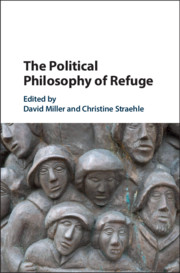Book contents
- The Political Philosophy of Refuge
- The Political Philosophy of Refuge
- Copyright page
- Contents
- Contributors
- Introduction
- Chapter 1 Differentiating Refugees
- Chapter 2 The State’s Right to Exclude Asylum-Seekers and (Some) Refugees
- Chapter 3 Asylum, Speech, and Tragedy
- Chapter 4 Border Rescue
- Chapter 5 Selecting Refugees
- Chapter 6 Refugees and the Right to Remain
- Chapter 7 The Duties of Refugees
- Chapter 8 Is Return the Preferred Solution to Refugee Crises?
- Chapter 9 Refugees and the Right to Return
- Chapter 10 Refugees, Rescue, and Choice
- Chapter 11 Philosophical Foundations for Complementary Protection
- Chapter 12 The Ethics of Sanctuary Policies in Liberal Democratic States
- Bibliography
- Index
Chapter 1 - Differentiating Refugees
Asylum, Sanctuary and Refuge
Published online by Cambridge University Press: 01 November 2019
- The Political Philosophy of Refuge
- The Political Philosophy of Refuge
- Copyright page
- Contents
- Contributors
- Introduction
- Chapter 1 Differentiating Refugees
- Chapter 2 The State’s Right to Exclude Asylum-Seekers and (Some) Refugees
- Chapter 3 Asylum, Speech, and Tragedy
- Chapter 4 Border Rescue
- Chapter 5 Selecting Refugees
- Chapter 6 Refugees and the Right to Remain
- Chapter 7 The Duties of Refugees
- Chapter 8 Is Return the Preferred Solution to Refugee Crises?
- Chapter 9 Refugees and the Right to Return
- Chapter 10 Refugees, Rescue, and Choice
- Chapter 11 Philosophical Foundations for Complementary Protection
- Chapter 12 The Ethics of Sanctuary Policies in Liberal Democratic States
- Bibliography
- Index
Summary
Debates concerning who is entitled to refugee status and what is owed to persons with that status have proliferated in recent years. Since Andrew Shacknove’s radical challenge to the 1951 Refugee Convention specification of refugeehood, posed against the background of the regional agreements expressed in the Organization of African Unity’s 1969 Convention Governing the Specific Aspects of Refugee Problems in Africa and the 1984 Cartagena Declaration on Refugees in Latin America, a range of accounts have been offered that, variously, defend, amend and extend the grounds and scope of the 1951 specification and identify distinct ranges of obligations owed to the figures they specify. In Section 1 of this chapter, I argue that the main axis of distinction within this debate is that between ‘humanitarian’ and ‘political’ pictures of refugeehood. That this is the case should not, I will argue, surprise us given the two pivots around which the modern refugee regime turns: the 1951 Refugee Convention and the UNHCR. Rather than attempting to decide between these accounts, my strategy in this chapter will be to propose a practice-based normative account of refugeehood. Thus, in Section 2, I sketch the historical development of the practice of refugee protection and the formation and development of the modern refugee regime. Attending to this history allows us, I will claim, to reframe the debate on ‘who is a refugee?’ in terms of the functional role of the refugee regime within an international order of states. In Section 3, drawing on previous work that identifies the functional role of the refugee regime as a legitimacy repair mechanism for global political society organized as an international order of states and which addresses refugees as persons for whom this order must stand in loco civitatis, I argue not only that the refugee regime has the scope to distinguish between distinct types of claim to refugee status in the light of the different normative grounds of these claims, but that a well-functioning refugee regime must so distinguish. The proposal that this chapter will defend is thus that we distinguish different types of refugeehood as distinct legal statuses within the general scope of the fundamental principle of non-refoulement in order to reconcile the pragmatics of refugee protection with the differentiation of normative claims at stake within this general status. I differentiate three basic types of claim – asylum, sanctuary and refuge – and explore what is owed to each of these types of claimant and the implications of such differentiation for the communicative role of the refugee regime in shaping the appropriate response of the international community to the state from which refugees take flight (or to which persons are unwilling to return).
- Type
- Chapter
- Information
- The Political Philosophy of Refuge , pp. 19 - 38Publisher: Cambridge University PressPrint publication year: 2019
- 6
- Cited by



